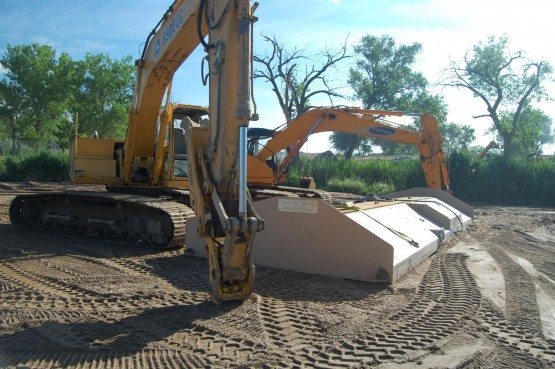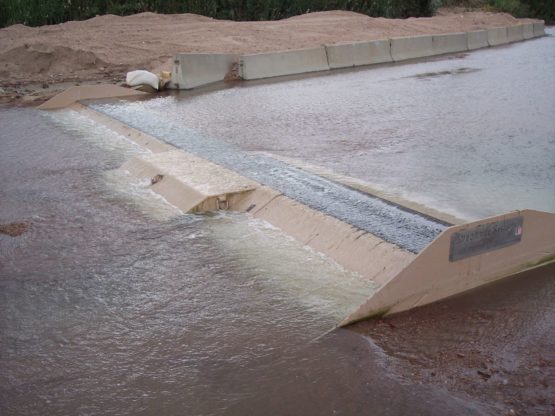Fountain Creek Bedload Interceptor
The Bedload Sediment Collector (Bedload Interceptor), was deployed and installed into Fountain Creek, Pueblo, CO after initial testing and evaluation on Fountain Creek and working with the Fountain Creek Watershed, Flood Control, and Greenway District, NRCS, City of Pueblo, Pueblo County, Colorado Water Conservation Board, and other key organizations to make the project happen. The project was funded through EPA 319 grant, with additional funding through organizations listed above. Also, a USACE Coastal and Hydraulics Engineering Technical Note (CHETN) was drafted following operations and monitoring of the Bedload Interceptor.
A 30-foot wide Bedload Interceptor was installed upstream of the confluence of the Arkansas River on Fountain Creek as a pilot to evaluate performance of the Bedload Collector as a dredging alternative. The 30-wide Bedload Sediment Collector selectively collects sediment migrating at the bottom of the river as bedload once it falls through its sized grates and into its hopper. The Sediment Collector is directly connected to a submersible pump in a dry well along the shore where it pumps the sediment slurry collected in the Sediment Collector to a feed box above a fine-material screw separator on shore. The separator dewaters the sediment and drops it onto a stacker conveyor for stockpiling for beneficial reuse of the collected material.
The Bedload Interceptor project was established as a pilot program to determine performance. Based on the evaluation of the sediment collector over a 1-year time frame, the USACE Technical Note reported under peak flow conditions that the Bedload Interceptor displayed a performance of over 8,000 lbs of sediment harvested per minute. This high collection rate under increase stream flow conditions showed great performance variability in the Beload Interceptor, and continued installations have been recommended. A full sustaining operations plan would need to be established for additional operations at this site.
The Bedload Sediment Collector (Bedload Interceptor), was deployed and installed into Fountain Creek, Pueblo, CO after initial testing and evaluation on Fountain Creek and working with the Fountain Creek Watershed, Flood Control, and Greenway District, NRCS, City of Pueblo, Pueblo County, Colorado Water Conservation Board, and other key organizations to make the project happen. The project was funded through EPA 319 grant, with additional funding through organizations listed above. Also, a USACE Coastal and Hydraulics Engineering Technical Note (CHETN) was drafted following operations and monitoring of the Bedload Interceptor.
A 30-foot wide Bedload Interceptor was installed upstream of the confluence of the Arkansas River on Fountain Creek as a pilot to evaluate performance of the Bedload Collector as a dredging alternative. The 30-wide Bedload Sediment Collector selectively collects sediment migrating at the bottom of the river as bedload once it falls through its sized grates and into its hopper. The Sediment Collector is directly connected to a submersible pump in a dry well along the shore where it pumps the sediment slurry collected in the Sediment Collector to a feed box above a fine-material screw separator on shore. The separator dewaters the sediment and drops it onto a stacker conveyor for stockpiling for beneficial reuse of the collected material.
The Bedload Interceptor project was established as a pilot program to determine performance. Based on the evaluation of the sediment collector over a 1-year time frame, the USACE Technical Note reported under peak flow conditions that the Bedload Interceptor displayed a performance of over 8,000 lbs of sediment harvested per minute. This high collection rate under increase stream flow conditions showed great performance variability in the Beload Interceptor, and continued installations have been recommended. A full sustaining operations plan would need to be established for additional operations at this site.













